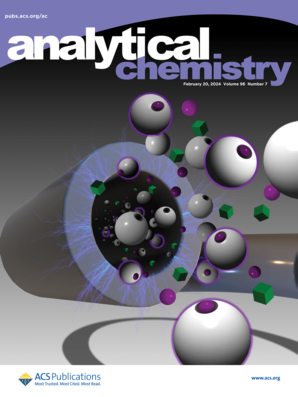用于即时免疫分析的双金属纳米酶协同效应驱动酶级联纳米反应器。
IF 6.7
1区 化学
Q1 CHEMISTRY, ANALYTICAL
引用次数: 0
摘要
本研究提出了一种利用NiCo普鲁士蓝类似物(PBA)双功能酶活性的癌症筛查比色传感器。通过引入氧空位和采用双金属掺杂策略,NiCo PBA克服了单金属掺杂材料(如Ni PBA和Co PBA)催化活性的局限性,显著提高了过氧化物酶样(POD)和过氧化氢酶样(CAT)活性。与单金属掺杂的Ni PBA和Co PBA相比,NiCo PBA的POD活性增加了30.08倍,CAT活性增加了4.83倍,对癌胚抗原(CEA)的检测灵敏度更高。将NiCo PBA与级联催化反应原理相结合,建立了一种高效灵敏的CEA检测方法。该方法以NiCo PBA为催化材料。在葡萄糖氧化酶的作用下,NiCo PBA催化过氧化氢分解,生成氧气。此外,当NiCo PBA与显色底物反应时,产生蓝色絮状物质。通过两种方法的相互验证,实现了血清样品中CEA的定量测定。实验结果表明,pod样活性检测范围为0.2 ~ 50 ng mL-1,检测限(LOD)为0.061 ng mL-1; cat样活性检测范围为0.1 ~ 20 ng mL-1,检测限(LOD)为0.028 ng mL-1。与单金属材料相比,该方法的灵敏度大大提高。此外,该策略具有良好的可扩展性,通过替换不同的识别单元,可适应多种分析物的检测,为早期癌症筛查提供了高效的检测平台。本文章由计算机程序翻译,如有差异,请以英文原文为准。
A Bimetallic Nanozyme Synergistic Effect-Driven Enzyme Cascade Nanoreactor for Instant Immunoassay.
This study presents a colorimetric sensor for cancer screening utilizing the bifunctional enzyme activity of NiCo Prussian blue analogue (PBA), a PBA material. By introducing oxygen vacancies and employing a dual-metal doping strategy, NiCo PBA overcomes the limitations in catalytic activity observed in single-metal-doped materials (such as Ni PBA and Co PBA), significantly enhancing both peroxidase-like (POD) and catalase-like (CAT) activities. Compared to single-metal-doped Ni PBA and Co PBA, NiCo PBA exhibited a 30.08-fold increase in POD activity and a 4.83-fold increase in CAT activity, demonstrating higher sensitivity in carcinoembryonic antigen (CEA) detection. By integrating NiCo PBA with a cascade catalytic reaction principle, we developed a highly efficient and sensitive CEA detection method. NiCo PBA was utilized as a catalytic material in this method. Under the action of glucose oxidase, the decomposition of hydrogen peroxide was catalyzed by NiCo PBA, and oxygen was generated. Furthermore, a blue flocculent substance was produced when NiCo PBA was reacted with a chromogenic substrate. Through mutual verification by these two methods, the quantitative determination of CEA in serum samples was achieved. The experimental results demonstrated that the POD-like activity detection range was 0.2-50 ng mL-1, with a limit of detection (LOD) of 0.061 ng mL-1, while the CAT-like activity detection range was 0.1-20 ng mL-1, with an LOD of 0.028 ng mL-1. The sensitivity of this method was substantially increased compared to monometallic materials. Furthermore, this strategy possesses good scalability and can be adapted for the detection of various analytes by replacing different recognition units, providing an efficient detection platform for early cancer screening.
求助全文
通过发布文献求助,成功后即可免费获取论文全文。
去求助
来源期刊

Analytical Chemistry
化学-分析化学
CiteScore
12.10
自引率
12.20%
发文量
1949
审稿时长
1.4 months
期刊介绍:
Analytical Chemistry, a peer-reviewed research journal, focuses on disseminating new and original knowledge across all branches of analytical chemistry. Fundamental articles may explore general principles of chemical measurement science and need not directly address existing or potential analytical methodology. They can be entirely theoretical or report experimental results. Contributions may cover various phases of analytical operations, including sampling, bioanalysis, electrochemistry, mass spectrometry, microscale and nanoscale systems, environmental analysis, separations, spectroscopy, chemical reactions and selectivity, instrumentation, imaging, surface analysis, and data processing. Papers discussing known analytical methods should present a significant, original application of the method, a notable improvement, or results on an important analyte.
 求助内容:
求助内容: 应助结果提醒方式:
应助结果提醒方式:


